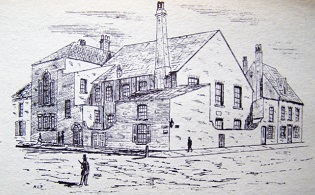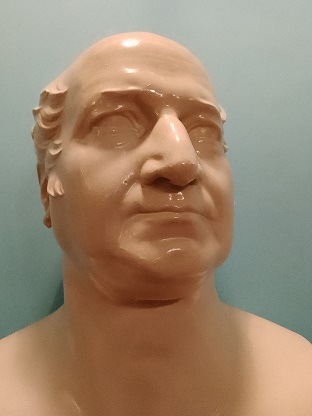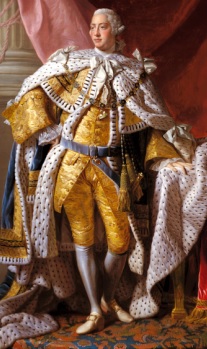The Nineteenth Century
England was powerful: with overseas trade and a rapidly growing commercial infrastructure, Britain was the most powerful trading nation in the world. Nonetheless, many lived a hand-to-mouth existence, working long hours in harsh conditions: the rhythm of life revolved around the hours of daylight. The Minerva Brethren were not unaware of this, of course, and had already resolved that an annual sum be paid to the Hull Royal Infirmary, becoming one of the oldest subscribers to that institution. There was a fund organised for the encouragement of Sunday Schools. As Hull was a significant port, the Lodge attracted many members from overseas, including, Germany, Norway, Sweden, Denmark, Finland, Holland, France, Italy, Prussia, the USA and even Van Dieman's Land (Tasmania). These in the main were merchants, mariners and members of the Military and Naval Forces.
Fashions were changing: the tricorn giving way to taller hats of various styles akin to the top hat. The Minerva Brethren decided to follow the recent example of the Phoenix Lodge and to purchase their own building and voted a payment of five guineas to Brother Richmond, landlord of the Masons Arms to compensate for his loss of custom.
 The Lodge building was on a piece of land owned by the Swedenborgian trustees who had the adjoining old chapel in Dagger Lane. Originally it comprised only an upper and a lower room, the latter let to Thomas Medd, who was a currier, colouring, sealing and finishing tanned animal hides to provide workable leather for manufacturers. Access to the Lodge was through a doorway to the left of the Senior Warden’s Chair – now a cupboard.
The Lodge building was on a piece of land owned by the Swedenborgian trustees who had the adjoining old chapel in Dagger Lane. Originally it comprised only an upper and a lower room, the latter let to Thomas Medd, who was a currier, colouring, sealing and finishing tanned animal hides to provide workable leather for manufacturers. Access to the Lodge was through a doorway to the left of the Senior Warden’s Chair – now a cupboard.
As there was only the one room, it was used for the ceremonies and also for refreshment, for which the Lodge would be “called off”.
 The design was the work of Bro Frank Appleyard (his bust is behind the JW’s Chair). Frank was Worshipful Master of the Minerva Lodge in 1818 and again in 1835. Brother M C Peck spoke of him in the Temple, much later: "He was a Brother of whom the Minerva Brethren have every reason to be proud, and whose memory I trust will be revered by them: it was to him we owe the elegant Hall in which we are now assembled, its fine proportions were his own design, the prosperity of the Lodge was his study and his happiness."
The design was the work of Bro Frank Appleyard (his bust is behind the JW’s Chair). Frank was Worshipful Master of the Minerva Lodge in 1818 and again in 1835. Brother M C Peck spoke of him in the Temple, much later: "He was a Brother of whom the Minerva Brethren have every reason to be proud, and whose memory I trust will be revered by them: it was to him we owe the elegant Hall in which we are now assembled, its fine proportions were his own design, the prosperity of the Lodge was his study and his happiness."
The sculptor was Thomas Earl, initiated into the Lodge in 1845, grandson of George Earl, who was one of the original members and a stone mason. Thomas's father was John Earle. The Earles were well known in Hull for ship building and repairs, the cement business, and sculptures; the statue of Queen Victoria in the city centre Square is by Thomas Earle.
Lodge meetings were frequent, and like many early Lodges, built around the Four Quarter Days, which relate to the solstices. The Lodge met once a month (on the fourth Wednesday from Lady Day (25th March) to Michaelmas (fourth Wednesday closest to 29th September) and twice a month (second and fourth Wednesdays) during the rest of the year. Nowadays the Wednesdays are fewer, and Installation is on the Saturday in June closest to Midsummer’s Day, the Summer Solstice or St. John the Baptist's Feast Day. (The other Quarter Day is 25th December, Christmas Day.)
In the early days there were several processions in regalia, celebrating important historical events. The regalia was not yet standardised, and there is evidence that Masons would sometimes decorate their aprons themselves. After the union, processions were prohibited unless with dispensation.
 The first recorded Minerva procession was on November 5th 1788 when the Brethren joined with the Brethren of Rodney Lodge and processed to Holy Trinity Church, commemorating “the birthday of our royal Brother, King William the Third.” This was William of Orange, who was King of England, Ireland and Scotland from 1689 until his death in 1702.
The first recorded Minerva procession was on November 5th 1788 when the Brethren joined with the Brethren of Rodney Lodge and processed to Holy Trinity Church, commemorating “the birthday of our royal Brother, King William the Third.” This was William of Orange, who was King of England, Ireland and Scotland from 1689 until his death in 1702.
Masonry was more open then, and events were sometimes advertised in the newspapers. The Minerva Lodge celebrated the Golden Jubilee of King George III (along with the Rodney Lodge, the two Lodges enjoying a strong fraternal friendship) in October 1809 – the Brethren met at 9.30 am and the two Lodges joined ranks and proceeded to the Mansion House where they joined the Mayor and Corporation in a procession to Holy Trinity Church (now Hull Minster) for a service. Afterwards they returned to Lowgate, then, led by a marching band, walked back to Prince Street for a meal. Afterwards they went to Jarratts Close, Sculcoates for a firework display. In 1811 there was a procession of the Minerva Brethren to church in honour of the birthday of HRH the Prince Regent. Incidentally, George III was the first English monarch to celebrate a Golden Anniversary (fifty years) - subsequently only Queen Victoria and Queen Elizabeth II have enjoyed this distinction.
--ooOoo--

